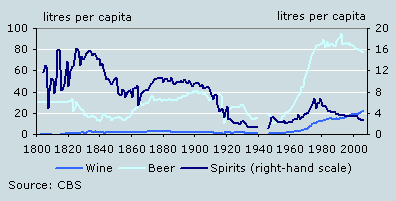The Netherlands: an island of moderation within Europe

Although the Dutch have a reputation of being heavy drinkers, they are in fact not: nearly nowhere in Europe do people drink as little as in the Netherlands. The country has had this position of an ‘island of moderation’ within Europe as long as comparative alcohol statistics have been published. Statistics on alcohol consumption are among the longest standing statistics in the Netherlands, which is one reason to put them in spotlight in History Week.
Alcohol consumption

Moderate drinkers
Two centuries ago, alcohol consumption – beer, wine, spirits – was high in the Netherlands. In the years 1820–1840 it was the equivalent of 8 to 10 litres of pure alcohol per person per year. It subsequently fell to under 5 litres per person in the mid-1850s, to stabilise around 7 litres after that. After 1900, consumption fell quickly to 1.5 litres in the 1930s.
It would be 1970 before the Dutch drank as much as they did around 1830 again. As a result of increasing prosperity, the consumption of spirits grew from 5.5 litres of pure alcohol per person in 1970 to 8 litres in 1995. This amount places the Dutch among the most modest drinkers in Europe. People in Luxembourg drink most, consuming the equivalent of more than 12 litres of pure alcohol in 2003. The Irish and Germans follow with more than 10 litres each. The Dutch drank 7.9 litres in 2003. Only in Greece, Italy and Sweden do people drink less.
Alcohol consumption in Europe, 2003

‘Social revival’
Statistics Netherlands has a strong tradition of alcohol statistics. The oldest consumption figures were the work of Henri Methorst, the first director of Statistics Netherlands. In 1899, he calculated the consumption of alcohol from 1830 onwards, and also gave an explanation for the decrease he observed.
Methorst gave three reasons for the trend of increasing moderation: 1. the introduction of the alcohol act (1881), which reduced the number of locations selling alcoholic beverages; 2. the increase in active sports participation, which was accompanied by moderation; and 3. the success of the organised temperance movement, which was part of what he called a broader social revival ‘réveil social’.
His analysis was the perfect illustration of what the new statistical office was capable of. The bureau had been founded to provide relevant statistics for social politics, and did so proficiently and with conviction.
Relevant, not necessarily undisputed figures
Statistics Netherlands was given responsibility for the official alcohol consumption statistics from 1916 onwards. The bureau took over the publication from the Ministry of the Interior, which thought the consumption figures were unreliable. The statistics were indeed unsubstantiated, but Statistics Netherlands succeeded in presenting the figures with scientific verification. The figures were still not undisputed, but Methorst was convinced that social debate was served by relevant, not necessarily undisputed figures.
Moderation partly a result of the temperance movement
In the 1930s and 1940s, many statisticians at Statistics Netherlands conducted model analyses of the consumption of beer and spirits. In 1942 it was the famous Jan Tinbergen who calculated alcohol consumption. The reason Methorst had given for the fall in alcohol consumption was shown by Tinbergen to be a significant factor in his model: the influence of the temperance movement.
Ronald van der Bie